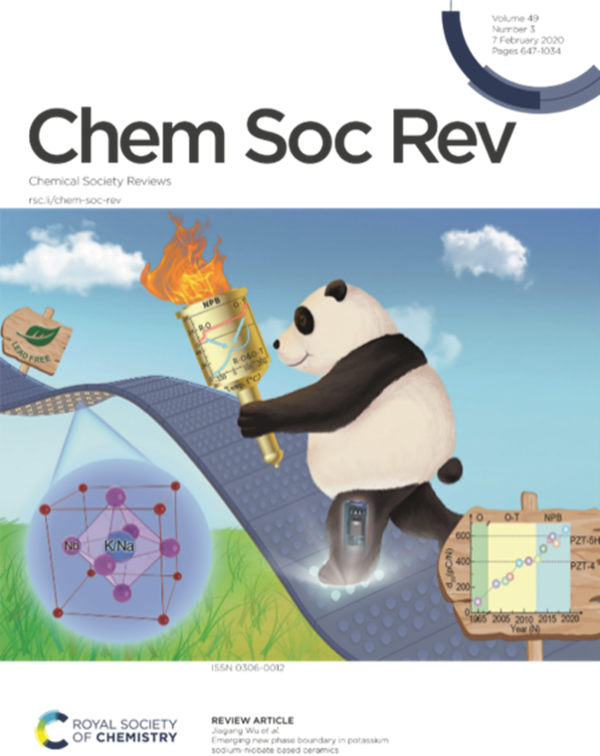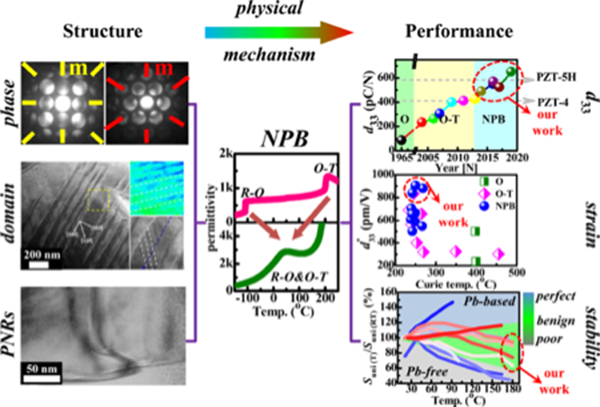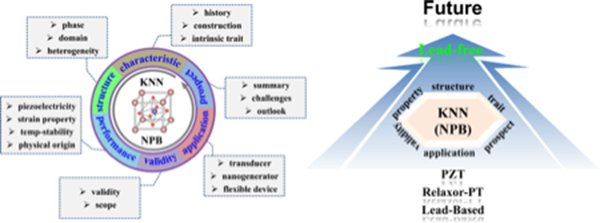In cooperation with Professor Xi-xiang Zhang ofKing Abdullah University of Science and Technology, a research team of Professor Jiagang Wu from Department of Materials Science, Sichuan University has published in Chemical Society Reviews a review article titled “Emerging New Phase Boundary in Potassium Sodium-Niobate Based Ceramics” (Chem. Soc. Rev. 2020, 49, 671-707). Being published as a cover story of that edition. this article systematically introduces the recent progress the team has made regarding new phase boundary of potassium sodium-niobate based ceramics, piezoelectric performance control, device development and physical mechanism. Sichuan University is the first work unit. The first author of the paper is Dr. Xiang LV of Sichuan University, and Professor Jiagang Wu is the only corresponding author.

Fig. 1: The article is featured as the cover story.

Fig. 2. Effect of new phase boundary on the structure and properties of KNN based ceramics
“It was not until 2014 that our group initially proposed a new phase boundary (NPB) that simultaneously improved the piezoelectric properties and temperature stability of non-textured KNN-based ceramics to the level of partly lead-based ceramics. The NPB has been then proved by some researchers and believed to pave the way for “lead-free at last” proposed by E. Cross (Nature, 2004,432, 24). However, the understanding of the NPB is still in its infancy, leaving many controversies, including the phase structure and physical mechanisms at the NPB as well as the essential difference when compared with other phase boundaries. In this context, we systematically summarized the origin and development of the NPB, focusing on the construction, structure and intrinsic trait of the NPB, the effects of the NPB on the performance, and the validity and related incipient devices of the NPB. Particularly, we concluded the phase structure and domain structure locating at the NPB, analyzed the physical mechanisms in depth, proposed the possible methods to further improve the performance at the NPB, and demonstrated the validity and scope of the NPB as well as the device application. Finally, we gave out our perspective on the challenges and future research of KNN-based ceramics with NPB. Therefore, we believe that this review could promote the understanding of the NPB and guide the future work of KNN-based ceramics.” (Abstract)

Fig. 3. Structure of this review paper and development prospect of lead-free piezoelectric materials in the future.
Dr. Xiang LV, the first author of this article, completed his master’s and doctoral program (2011.9-2019.6) at Department of Materials Science, Sichuan University. At present, he is a postdoctoral research fellow under Professor Xi-xiang Zhang at King Abdullah University of Science and Technology in Saudi Arabia. His research is mainly focused on component design, performance regulation and physical mechanism of lead-free piezoelectric materials. So far, in the capacity of a first author (including co first author and corresponding author), he has published 21 SCI papers in journals, including Adv. Mater, ACS Appl. Mater. Interfaces (3), J. Mater. Chem. A / C (2), Acta Mater, Adv. Electron. Mater.
The above work was funded by the National Science Fund for Distinguished Young Scholars.
Article link:https://pubs.rsc.org/ko/content/articlelanding/2020/cs/c9cs00432g#!divAbstract
